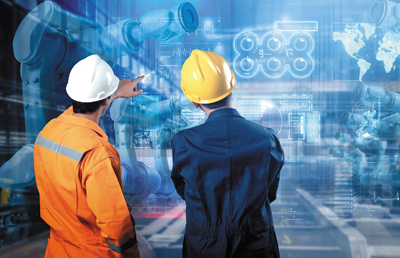Why “Humans + Automation + AI = The New Supply Chain Workforce” is the optimal formula for operational success.

By Sara Pearson Specter
Multiple surveys have confirmed that—as a result of COVID-19—companies worldwide are accelerating their investments in digital technologies as a means to better anticipate and forestall future disruptions. KPMG’s 2020 CEO Outlook, for example, found that 74% are digitizing operations to create a next-generation operating model, while 70% are creating new digital business models and revenue streams.
Perhaps most pivotal, however, is KPMG’s finding that 66% of the respondents are creating a new workforce model built on automation and artificial intelligence (AI) designed to collaborate with human workers.
Leveraging intelligent technologies to help humans perform tasks more effectively remains controversial, however. On one side, some fear the loss of supply chain jobs to automated solutions, from order pickers and machinists to forecasting and procurement managers. Conversely, others say such solutions will relieve humans of the routine, mundane, boring, dirty and dangerous jobs that are already hard to fill, while simultaneously creating new, better paying jobs that add more value.
Neither side is wrong, said Dana Stiffler, vice president and analyst with Gartner Research. “We’ve seen automation replace humans for over a century; that’s the story of the industrial revolution,” she said. “There are definitely hourly roles in manufacturing and warehousing that are certainly at more risk than others. And now, more white-collar roles are as well.”
Gartner’s view, Stiffler continued, is that technologies such as AI, machine learning (ML), and automation will not necessarily replace humans, but rather prompt a redefinition of roles.
“When we talk to leaders of big supply chain organizations, they’re working to figure out which of these roles are redefined and what skills are required,” she explained. “They’re making every effort to transition as many employees as possible to new roles by giving them the tools, development and managerial support they need.”
It’s an opinion shared by all of the experts who contributed their insights to this article.
Joe Campbell, senior manager of strategic marketing and application development at MHI member Universal Robots, reported similar observations. “I haven’t talked to a plant manager in over a decade who’s said, ‘we’re going to put some robots in and lay people off.’ It’s just not happening.”
Campbell points to the generational shift in the workforce, noting that Baby Boomers are retiring at rates in excess of 10,000 a day—which has had a significant impact on workforce availability in both manufacturing and warehousing. His manufacturing contacts have shared that, with the pandemic, more employees are electing to retire earlier, often at age 62, out of exposure concerns.
“Further, the younger generations are absolutely not interested in work they perceive to be dull, dirty or dangerous,” he added, noting that issue already challenged employers seeking to hire logistics and manufacturing workers before the pandemic. “Pre-COVID, there were more than half a million unfilled manufacturing jobs. Adding automation allows an operation to move skilled workers into higher value, higher margin tasks that keep them engaged.”
 MHI Solutions Improving Supply Chain Performance
MHI Solutions Improving Supply Chain Performance